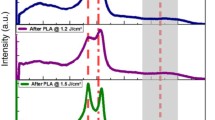Abstract
Thermal annealing effects on carbon-hydrogen (C-H) complexes defects in AlGaN grown on sapphire by metalorganic chemical vapor deposition (MOCVD) technique have been investigated using Fourier transform infrared spectroscopy (FTIR). The CH complexes in AlGaN, formed either during growth or by proton irradiation, exhibit five local vibrational modes (LVMs) due to the symmetric and asymmetric vibrational stretching modes of C-H in CHn (n=1–;3) defect complexes. It was found that the annealing temperature (Ta) of 500°C is sufficient enough to dissociate most of the C-H complexes in AlGaN samples. A turning point annealing temperature is found around 300°C for un-irradiated Mg-doped sample, below which the total integrated area of the C-H LVMs continued to increase with increasing annealing temperature and reach the maximum value around 300°C. At Ta > 300°C, the total integrated area of the C-H LVMs starts to decrease and the C-H complexes seem to be completely depleted at Ta > 600°C. The depleted C-H LVMs were observed to partially recover after thermal annealing at Ta > 500°C and waiting for aging periods of several days. This recovery behavior is explained in terms of the hydrogen being remained inside the crystal after the dissociation of C-H complexes, subsequent diffusion and recombining again with carbon atom to reform C-H complexes.
Similar content being viewed by others
References
S. Nakamura, T. Mukai, and M. Smoh, Appl. Phys. Lett. 64, 1687(1994).
S. Nakamura, G. Fasol, in: “The Blue Laser Diode”, (Springer, New York, 1997).
M.S. Shur and M.A. Khan, GaN/AlGaN Heterostructure devices: Photodetectors and Field Effect Transistors, MRS Bulletin 22(2), pp. 44–50, Feb. (1997).
M. Razeghi and A. Rogalski, Semiconductor ultraviolet detectors, J. Appl. Phys. 79(10), 7433 (1996).
K. Doverspike, A.E. Wickenden, S.C. Binari, D.K. Gaskill, J. A. Freitas, Mat. Res. Soc. Symp. Proc. 395 (1996) 897.
S. Nakamura, N. Iwasa, M. Senoh, and T. Mukai, Jpn. J. Appl. Phys., Part 1 31, 1258 (1992).
J. Neugebauer and C. G. Van de Walle, Phys. Rev. Lett. 75, 4452 (1995).
W. Gotz, N. M. Johnson, D. P. Bour, M. D. McCluskey, and E.E. Haller, Appl. Phys. Lett. 69, 3725 (1996).
G. C. Yi, and B. W. Wessels, Appl. Phys. Lett. 70(3), 357 (1996).
H. Wieder, M. Cardona, and C. R. Guarnieri, Phys. Status Solidi B 92, 99 (1979).
Y. Tawada, K. Tsuge, M. Kondo, H. Okamoto, and Y. Hamakawa, J. Appl. Phys. 53, 5273 (1982).
B. Dischler, A. Bubenzer, and P. Koidl, Solid State Commun. 48, 105 (1983).
“GaN and Related Materials”, edited by S. J. Pearton, Vol 2, Chapter 11, (Gordon and Breach, Amsterdam, 1997).
L. Hoffmann, E. V. Lavrov, B. Bech Nielsen, B. Hourahine, R. Jones, S. Öberg and P. R. Briddon, Phys. Rev. B 61 No. 24, 16659 (2000).
Author information
Authors and Affiliations
Rights and permissions
About this article
Cite this article
Manasreh, M.O., Weaver, B.D. Thermal Anneal Effects on Carbon-Hydrogen LVMs In AlGaN. MRS Online Proceedings Library 692, 1041 (2001). https://doi.org/10.1557/PROC-692-H10.4.1
Published:
DOI: https://doi.org/10.1557/PROC-692-H10.4.1




